This article part 1 of 2 is about bees, largely about the honeybee, and certain aspects related to it, such as the current swarming season at the end of june and in july (in the northern hemisphere), spiritual aspects of the bee and other interesting facts.
THOUSANDS OF SPECIES
First of all, for an introduction, the Bee has thousands of species (over 16,000) and belongs taxonomically to the insect kingdom (Insecta, superfamily Apoidea) which is classified under the animal kingdom (Animalia).
There are several species of bees such as the western and eastern honey bee (genus Apis = Latin for bee, 11 species, 43 subspecies), the bumble bee (over 250 species), and the meliponine bee. All three live in colonies.
But all other species (>90%) are solitary, such as the carpenter bee, the mason bee and the sweat bee. Both colony bees and solitary bees belong to the Hymenoptera (fleece-winged).
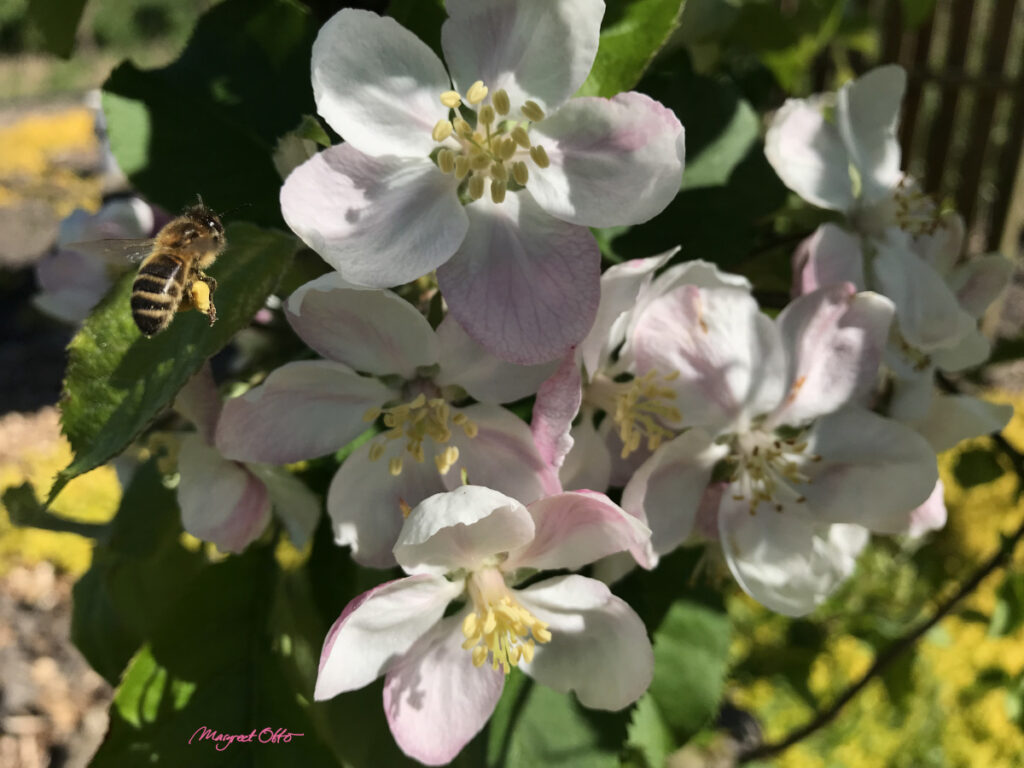
This bee flies towards the blossom of an apple tree.
If the blossom flower gets fertilised, an apple will grow out of it.
This works the same for all other fruit- and nut trees, berries and vegetables.
BEES FOR FOOD
The honey bee (Latin ‘Apis Mellifica’) and the bumble bee (Greek ‘Bombus’) could well be called the noblest of the insects. Both ensure the pollination of crops, plants, fruit and nut trees. Nearly 80% of all cross-pollinated plants can be pollinated by bees. Other insects also contribute, such as butterflies and certain fly species, and sometimes even by birds, but to a much lesser extent. That is why the mentioned bees are very important to us!

The Honey Bee ~ Apis Mellifica, on Rosa Rugosa.
THE HONEY BEE
As crème de la crème, the honey bee produces sweet honey for its own food, which is unique in the insect kingdom.
And with overproduction of honey by this winged insect species, humans may also consume a little of their liquid gold.
The honey bee is also the only bee species which builds a honey comb, which makes them very special.
They are also highly organised, they live in large colonies of between 20.000 and 80.000 worker bees, together with a queen bee, drones (male), and workers (female) for the beehive and to collect honey.
The bumble bee also produces honey, but very little and doesn’t build a honeycomb. It usually nests on the ground, for instance under a pile of autumn leaves.
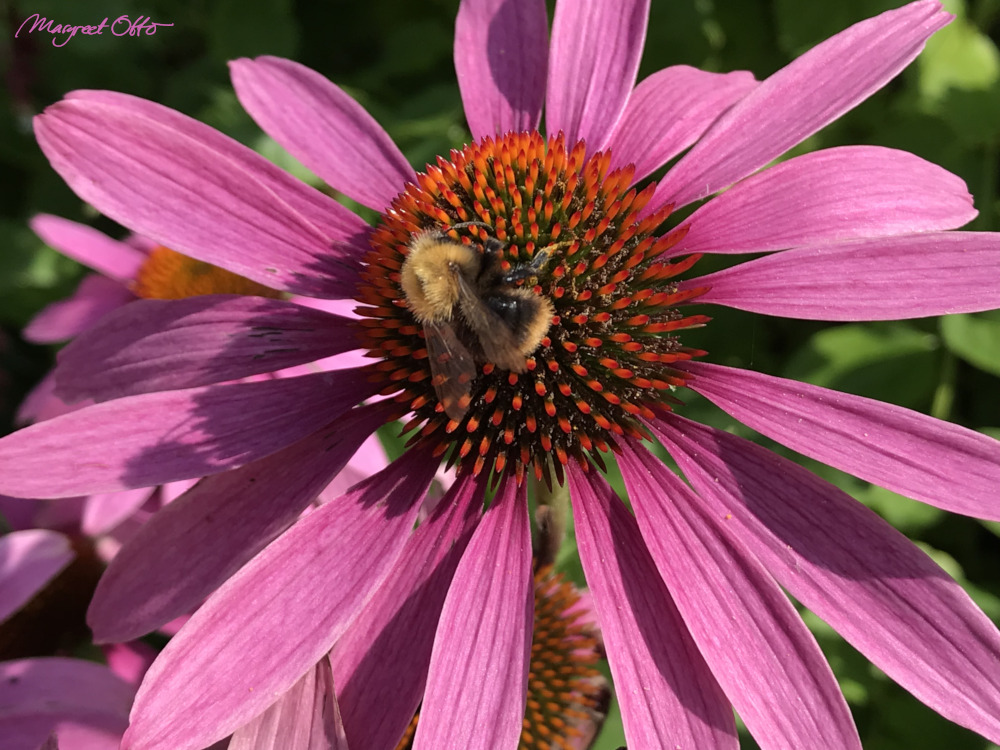
BumbleBee ~ Bombus, on Echinacea Purpurea – Cone flower
BEES SEEN FROM A SPIRITUAL PERSPECTIVE
The Dutch Marieke de Vrij released a bit of spiritual information about honey bees at meetings and gatherings of members of her organisation. Part of this info has been incorporated into this article and is placed in this color.
The information has been extended here and there for the purpose of this article related to the Earth Hectare Grid. Some things can still be changed with advancing insights or be added on later. However, it is important to share this information now, as in the northern hemisphere the end of spring is in sight and the beginning of summer has begun.
This is the period -the end of June and the month of July- when bees begin to swarm out to find a new home for their offspring. But… the Bee is currently having a very difficult time surviving in our civilized society. And that could also be noticeable in, among other things, their swarming behavior. But what exactly are the factors that contribute to this?
THE AFFECTED EARTH LIFE
In a world where people’s technocratic life has taken over, in big cities and areas with intensive traffic (cars & motorcycles, planes & ships), cell towers & satellites, air pollution, smog,
…the bees have difficulty in appearing communicative, as it were, in that very reticent way in which they normally live and function.
That is also the same for all animal species in a general sense, because Earth life shows itself to be so affected. In fact, the entire Earth energy field is disturbed and weakened. So what can we do to make bees’ lives more pleasant, which will also improve ours? First of all, it is important to know how the Bee functions as a living creature.
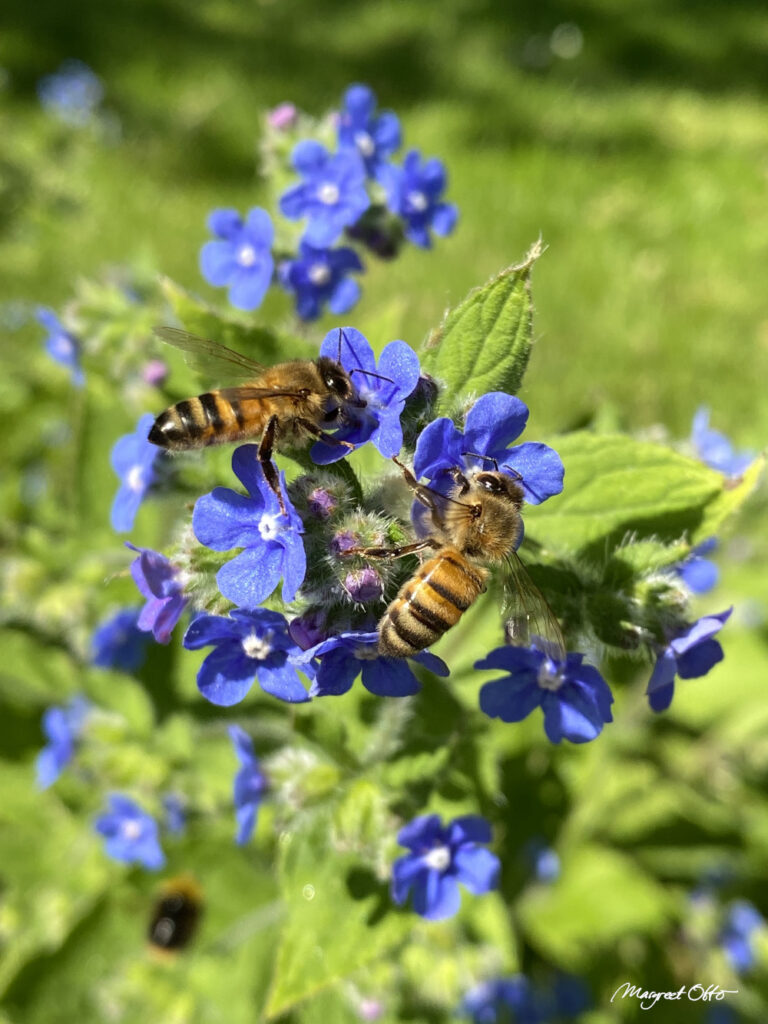
INDEPENDENT EXPERIENCE FIELD
Marieke de Vrij says about this:
A bee colony has a very independent field of experience in coordination with each other, with the intention of preserving the group atmosphere and limiting the urge to act to what really matters.
It is a species that can suffer from exhaustion quickly, with a highly sensitive antenna system, a sensitive system that quickly limits them.
This means that they are closely attuned to each other, but from an essential independent angle within each individual Bee, in relation to each other.So you can say they have a natural ‘I’ sense, but in a huge connection with the ‘We’.
WHEN A BEE COLONY IS LOST
The limitations that occur when the high-sensitivity is overused in a bee colony is that the ‘We’-feeling is undermined, and the ‘I’-awareness, the individual awareness of the individual Bee, is therefore only very diffusely present, because the independence of the individual Bee is always the prelude to the ‘We’ field of experience.
BROKEN REGISTERED MEMORY
This also means that if a bee colony dies, the cohesion of that colony is broken at a very deep level. As a result of which the individual Bee, as it were, no longer has a good storage memory of itself, and of the colony bees as a whole. That’s why it’s so dramatic.
DISORIENTATION OF BEES
Because, for example, a colony that is affected by too many cell towers, signals that emanate from it, suffers from disorientation, and that also means that the ‘I’-being of the individual Bee can no longer join the ‘We’ bees-group.
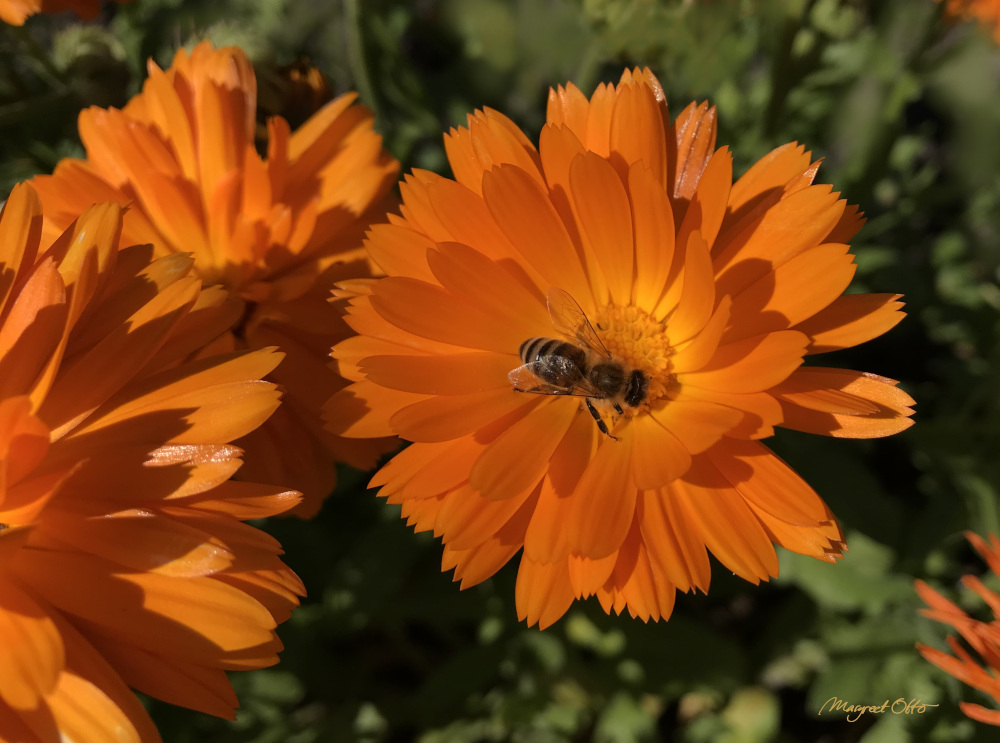
The Honeybee on a Marigold
BEES SWARM
In the spring and early summer, honey bees swarm when they want to form a new colony. The main reason for swarming can be compared to when children have grown up and leave home, so it is with the offspring of bees. Usually the old colony in the beehive has grown too large and therefore they split off, sometimes into several groups.
About 60% of the worker bees then fledge, together with the mature (old) queen bee that grew up in the hive. Scout bees fly ahead from the old shelter to find new suitable locations where they can settle. The swarm of bees, usually thousands of bees, then fly after it.
And until the suitable location has been found, the swarm sometimes needs to rest somewhere in the meantime. Then they all hang together on a sheltering branch of a tree, in a high bush or under a roof gutter. If you see something like this, a tangle of bees on top of each other, hanging on something, looking like a kind of buzzing big brown bunch of grapes, then the swarm has settled down for a short time.
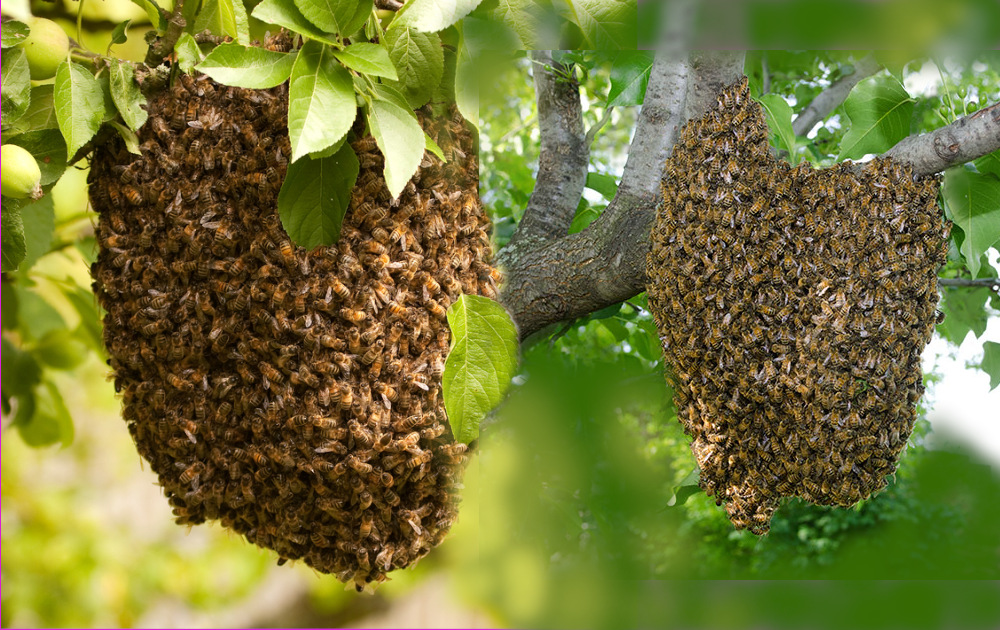
WHEN YOU ENCOUNTER A SWARM
When you find bees in the situation of a swarm, so a big bunch of bees hanging on something, and it’s the first time you see that, it can seem a bit scary. However, a bee swarm is usually not aggressive.
And if you keep your distance, because they will protect the queen when threatened, they basically do nothing. That’s because they only want one thing: a new location for a new home, and the bees have fed themselves full of honey to cope with this wandering, and are very docile as a result.
CALL A BEEKEEPER
It is best to immediately call a beekeeper or beeguardian who lives close to the location. Because a swarm usually doesn’t stick around for very long. Beekeepers like to collect swarms, especially since the bee population is not doing well these days.
And you also help the bees well, especially in built-up areas and landscapes with little nature, the bees have difficulty finding a suitable location. Otherwise, without human intervention, the bees will not survive and the swarm might perish.
BEE ESTABLISHMENT
By nature, bees prefer to settle in a small space to build their honeycomb, such as burrows or holes in tree trunks. They make the honeycombs themselves in these burrows and other suitable places, such as beneath sheltering branches of trees.
And they will undoubtedly prefer that, after all, bees are ‘programmed’ by nature to do so, so to speak. Thus a natural process is always better.
In built-up areas, they can also choose a gutter sheltered under a roof for instance. Due to the disappearance of forests, there are less suitable places for bees on the countryside to make their honeycombs.
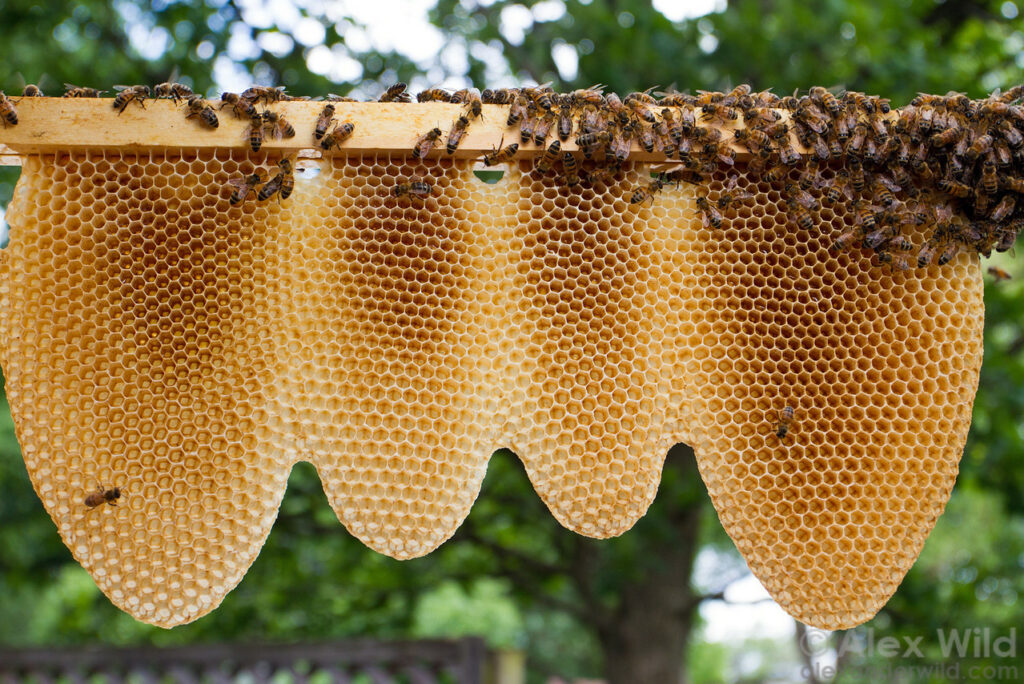
In a good habitat for the bees where there is sufficient flower food such as nectar and pollen, the bees can very well find their own shelter and make the combs themselves, which they do from their self-made wax.
The combs that bees themselves make are usually convex and have a curvature here and there, which results in some kind of large hanging drop shapes, as you can see above, which is here already filled with honey in the upper half.
THE WOODEN HYVE AND WICKER BRAIDED SKEP
Beekeepers can also provide an artificial shelter for a swarm, made by human hands. Those are wooden boxes as beehives, or wicker woven skeps made of different types of straw such as rotan or spelled differently rattan. Once a bee swarm has been collected, a beekeeper will usually house it in these man-made hives or skeps.
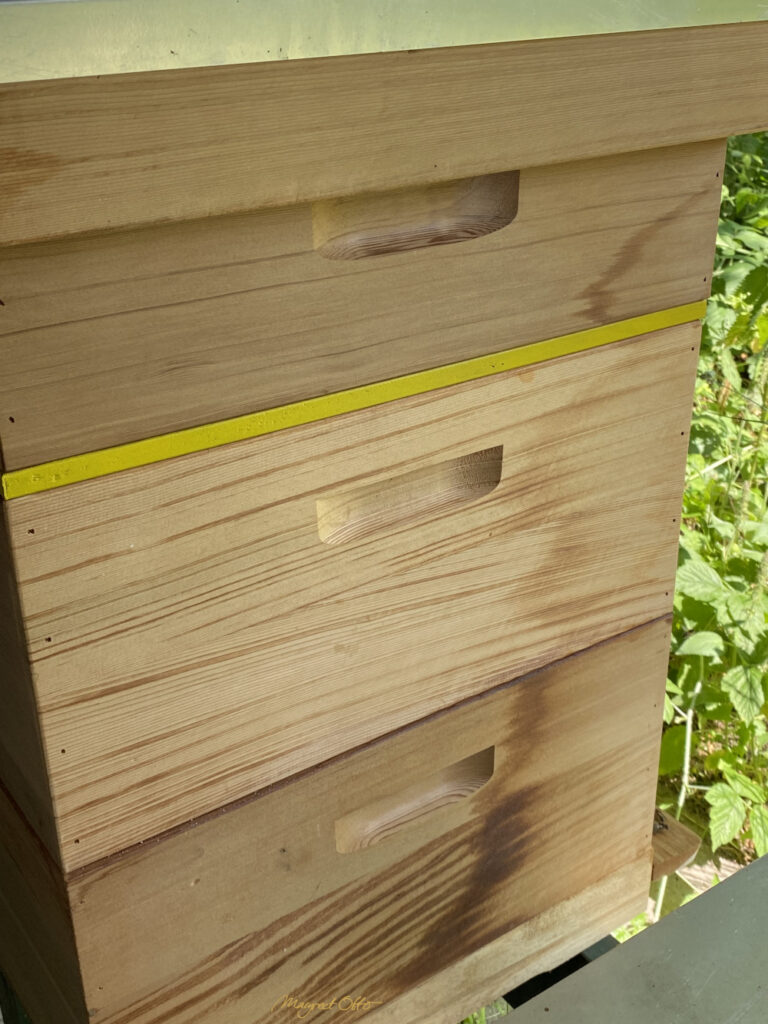
A side of a beautiful beehive, made of cedar wood.
Nowadays some skilled beekeepers fabricate beehyves from tree trunk parts with a hole in it resembling the bees’ natural habitat, without the artificial honeycombs in it, so the bees have to make those themselves.
The wicker skep is empty also and the bees start building the honeycombs themselves and attach it to the inside of the woven material. All types of bees housing need to have good ventilation and prior to a swarm entering, must be thoroughly cleaned with the right cleaning agents suitable for bees.
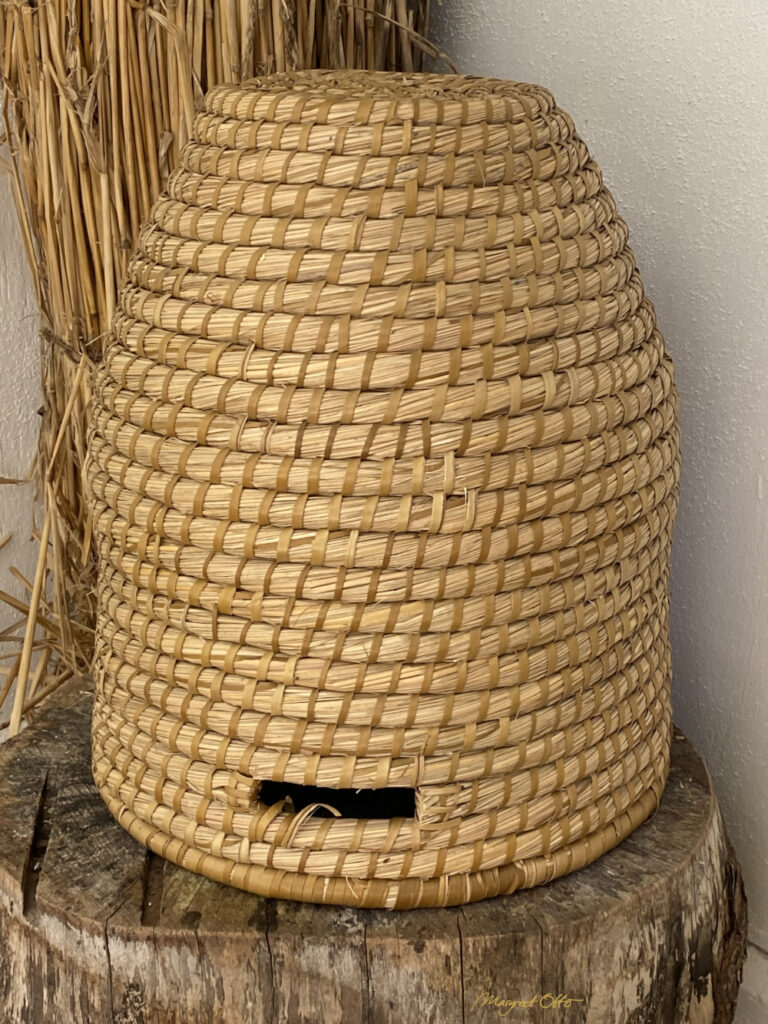
The skep straw hive for bees, is a wicker woven basket placed up side down, so it has no bottom. The bees construct and attach the honeycomb on the ‘ceiling’ and walls of the now hive.
The disadvantage of a skep is that it’s difficult for the beekeeper to harvest honey from the skeps without harming the colony, or to even inspect it for diseases and pests. However, when they are set up in pristine environments for the purpose of crop fertilization in organic agriculture and horticulture, the chance for pests is relativly small, and thus those skeps might be a relativly cheap but effective investment.
In the past the wicker braided skeps were plastered with mud and even dung. This would make the skeps sturdier and better insulated in wintertime. They also need proper ventilation. Nowadays the hyves and skeps are usually under a roof or shelter to protect them from windgusts, heavy prolongued rain or intense summer heat.
PREFAB HONEYCOMBS
For the start of a colony, the wooden beehyve boxes usually contain about ten to twelve rectangular frames of artificially prefabricated empty honeycombs with a flat surface, made by human hands. This saves time for the bees to collect nectar and pollen for honey production.
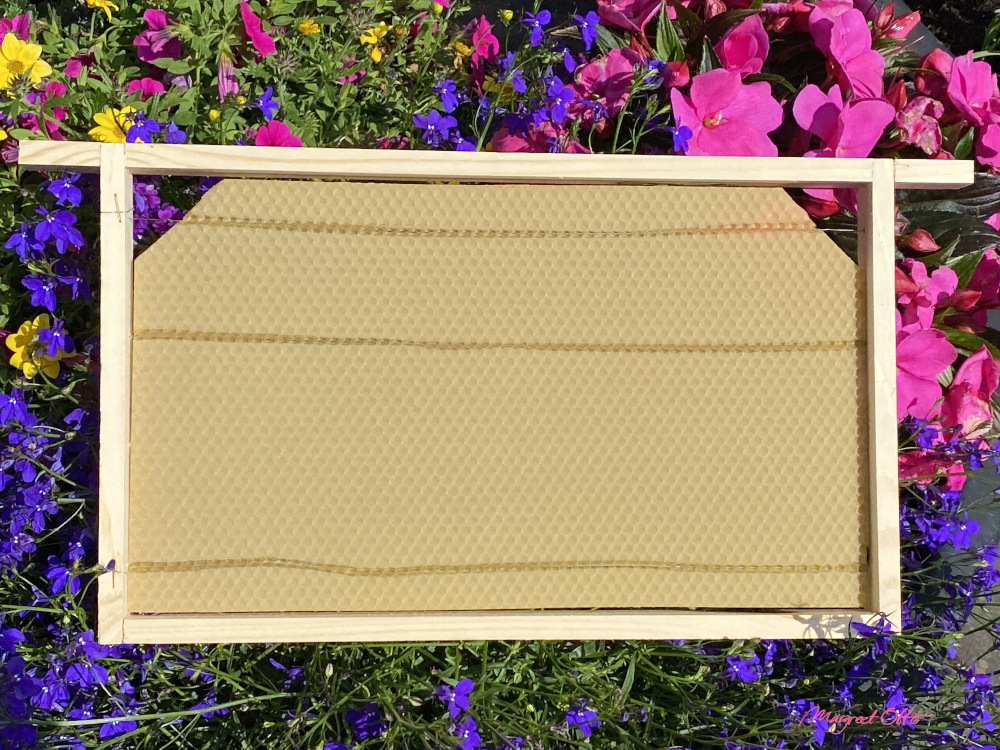
Empty man made prefab honeycomb
Thus the bees kept by beekeepers are in fact domesticated bees, versus the natural bee colonies. If you think about it, it’s a bit of an odd practice. But it has been done for thousands of years. And when managed well, bees can have a good life with the help of beekeepers and in a natural environment.
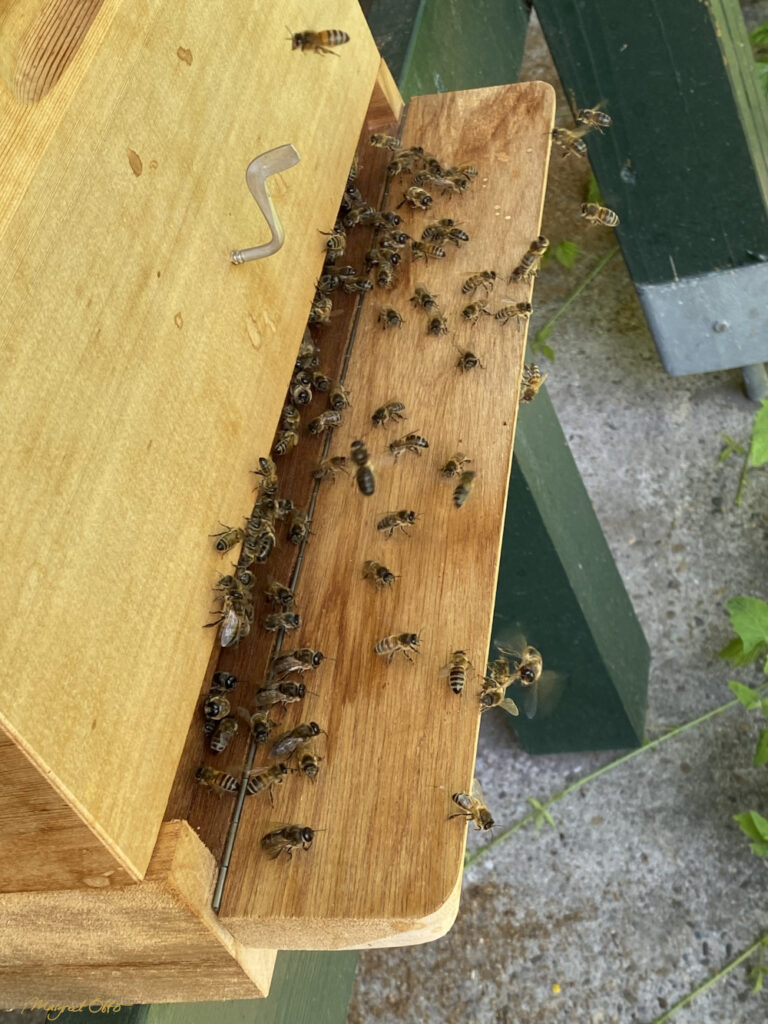
The entrace to beehives is usually at the bottom.
GIVE WATER
It is also important to give the flowering plants and trees enough water during drought so that the flowers and blossoms can produce enough nectar and pollen. This is also advisable in spring when the trees form blossoms to grow fruit. When there’s not enough water, the nectar can’t be formed, or not as much.
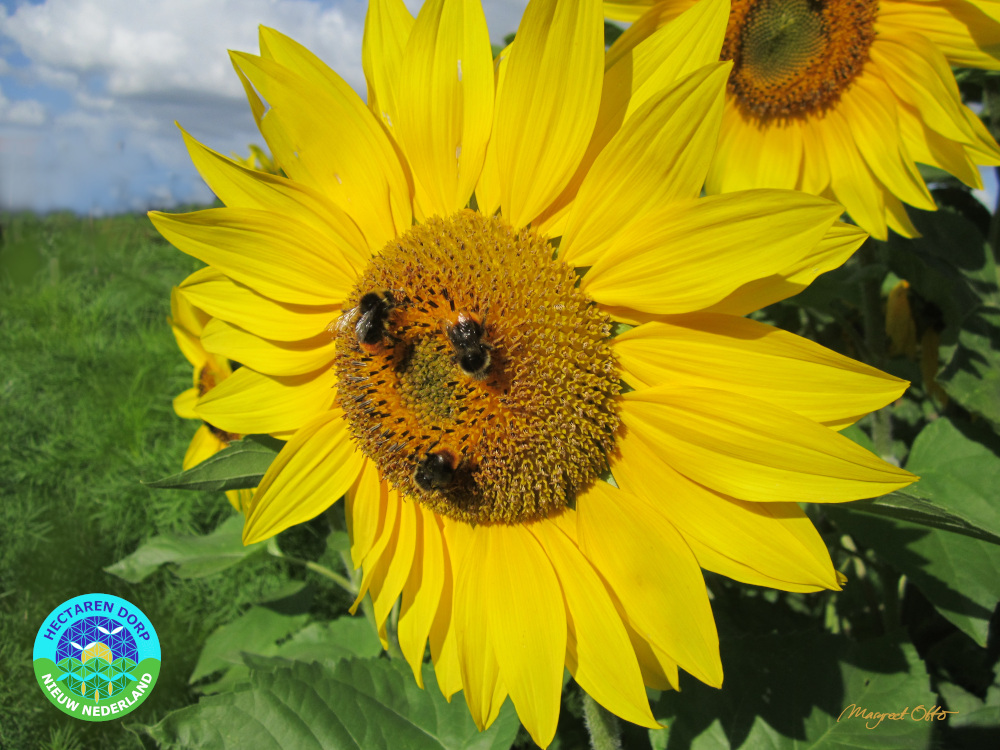
Three Bumblebees on Sunflower
PLANT SUITABLE PLANTS
If you have a garden or estate, you can also plant suitable perennials for bees in your garden, an example of which is lavender. The advantage of perennials is that they bloom every year and in principle require little maintenance, except for watering during drought. You can also sow annual plants, such as marigold. Here you will (soon) find a top ten list of suitable flowers.
‘DIALOGUE’ WITH THE FLOWER
The Bee is an exquisite ‘person’, capable of a very fine-grained and extraordinarily committed relationship with the flower, which it visits on an essential level and, as it were in dialogue with the flower, ‘peels off’ the pollen on a very own way. And there you see very specific individual characteristics per Bee show themselves differently.
So if you look at the individual Bee, they all have a slightly different approach. There are bees that start by picking the middle area of a pollen pistil, so to speak. And others start gnawing at the edges to make them frayed, making it easier for them to reach the panicle of the pollen corolla.
But whatever the approach route is, it also differs somewhat per bee species, it also has to do with the fact that the legs of the Bee, they actually want to nestle themselves a little deeply in the attachment of the flower, as far as possible.
But flying too long makes them tired, so if they can hang in one place like a helicopter, that’s very exhausting, they won’t last long.
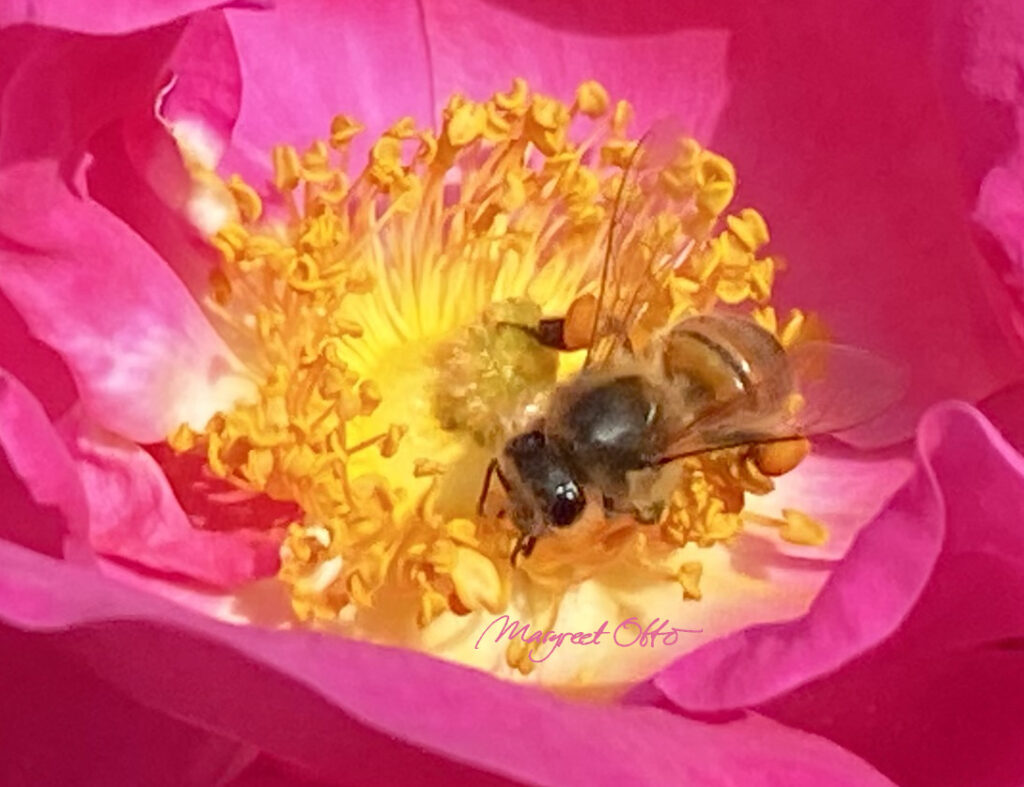
Attachment of bee legs to the flower.
On both hind legs pollen has been collected!
A BIT OF STABILITY
But a bee that finds a bit of stability in a pistil or a petal, and then can still reach the pistil, that differs per type of flower, will have much more stamina to peel off the pollen. And that is, as it were, experienced as pleasing by the flower. He finds it a pleasant experience, that tickling on the pollen.
NEW TIDE
For the flower itself it means that a new tide is ushering in, namely when the pollen has just been loosened, then slowly the advance begins, to germinate or sprout and blossom the experiences gained.
When the pollen has been transferred, you can symbolically say: ’then a flower breathes a sigh of relief’. Just trying to explain it in human language.
Because task-oriented has happened to which they (the plants and the flowers) have brought themselves into bloom. And then a slow die-off begins.
COMPLETED LIFE
With the pollen being taken in consultation with flower and Bee, and the flower also finding it pleasant, the flower then enters a completely different episode. So that’s also a very important ritual for the flower that is significant. Contrary to what you might expect, a flower is very happy in its dying process.
For then he will be so matured by the life he has produced that he will still, as it were, completely inhale the history that he has already completed! So the flower that is coming into a completed life may also know the happiness of that.
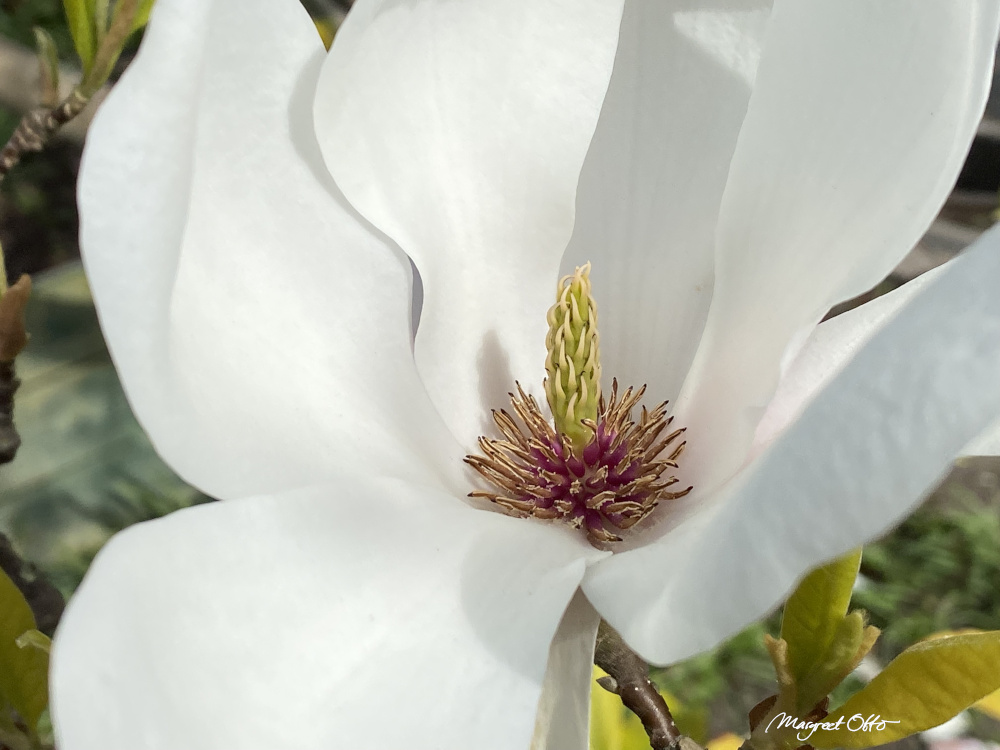
SUPPORTED BY THE COSMOS
The bee colony that then prepares to transfer the spared pollen also handles this on a ritual basis. Much has already been written about this, also by beekeepers, that is known. The bee colony feels intimately supported from the cosmos in its individual group enthusiasm.
IMMATERIAL LAYERS
Then we may ask ourselves: How do the bees feel supported from the cosmos?
First of all, it concerns very subtle atmospheres that already show themselves in an extremely rarefied way. You have all kinds of layers in immateriality. Immaterial beings that are already closer to matter, and you have immaterial layers in the immaterial world that are becoming more and more transparent. Closest to the Bee are the ‘spiritual peoples’ living on Earth, I cannot call them otherwise, who occur more and more sporadically in densely populated areas.
By ‘spiritual’, Marieke also means the ‘immaterial’. But what can we understand by ‘natural peoples’? First it translates differently from Dutch language, because we say ‘volk’ = folk to ‘peoples’ such as tribes, and also for a Bee-Folk. This translates more as ‘Bee-population’, or ‘Bee-Colony’, and we say ‘mensen’ to people. So the ‘natural peoples’ for this purpuse could very well be understood as ‘bee-population’ for this article.
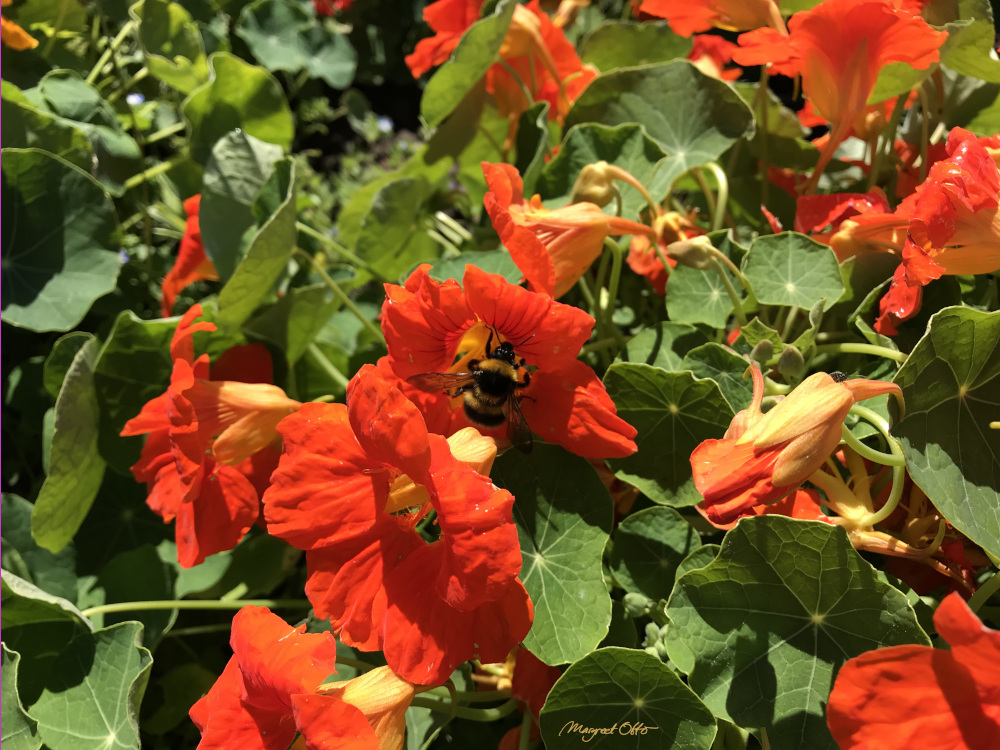
Seen from a broader perspective, can we also think of ‘natural peoples’ as ‘all conscious life’ that belongs to the domain of humans, as well as to the animal kingdom?
The spiritual ones still have a connection with nature, as basically all sentient beings are spiritual, either on this side or the other realms close to this Earth, in the auric field so to speak.
Can we also ponder a bit on this field of consciousness in the ether?
It essentially consists of other natural elements that form the elemental and etheric energy fields of the Earth.
THE EARTH ATMOSPHERE
Said energy fields are in fact the connecting sphere or transition sphere of the Earth’s atmosphere with the immaterial realms and the cosmos. ‘Atmo’ of atmosphere is Greek for ‘smoke’ or ‘vapour’, so atmosphere, and ‘smoke’ also refers to a finer or more volatile, more elusive composition of matter. This sphere also counts as the ‘aura’ of the Earth or as the ‘sphere of influence’ since the material and immaterial energy fields interact.
THE EARTH AS A LIVING ORGANISM
Large nature areas are much more connected to the Earth’s sphere of influence. Think, for example, of forests and vast woods, tundras, the tropical rainforest, but also the taiga, vast hilly landscapes and mountains. Here the Earth energies are strongest, because the Earth is a living organism nourished by nature.
However, as already described at the introduction, bees and other insects, but also many animal species, are having a hard time because of the affected Earth life.
The surrounding energetic layers of the Earth symbolically appear as a dark black mist, a thick quagmire of pollution and electrosmog. This was reinforced this spring by the current wildfires of enormous magnitude in Canada, Mexico and elsewhere in the world.
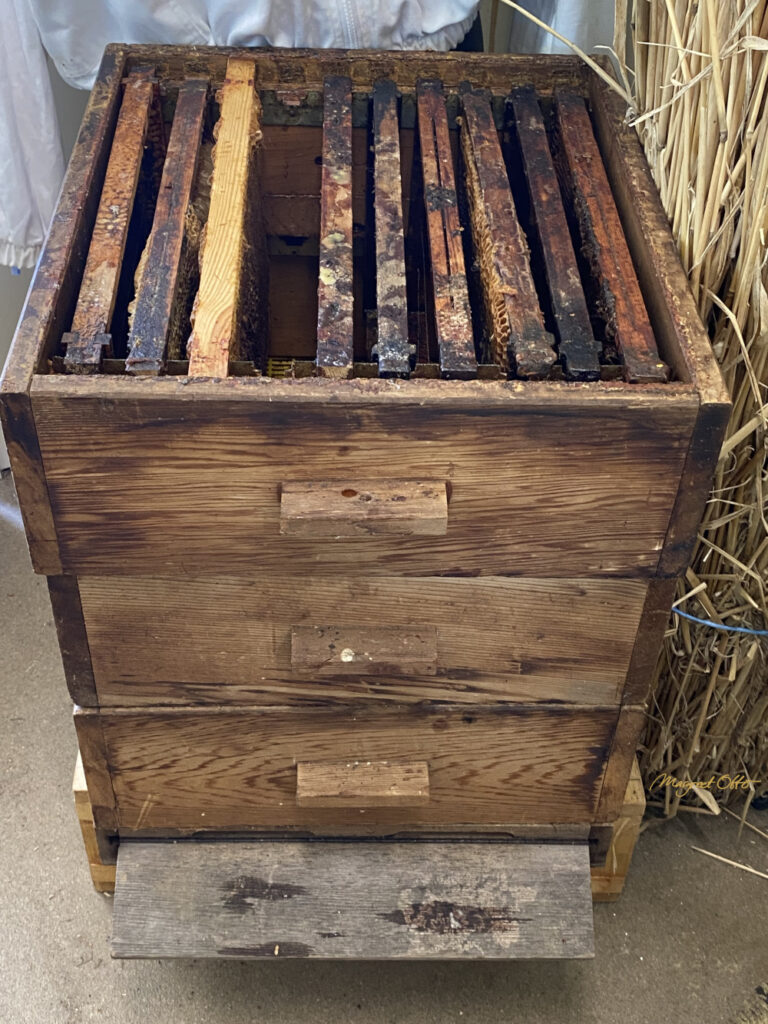
An almost antique beehyve. Must have served for a lifetime.
TELEPATIC OVERT SIGNALING
So the spheres that bees, symbolically described: have to ‘slog through’ to transmit their telepathic abilities, have become enormously condensed in many places.
That is why it has become extremely complicated for the bees (and many animal species) to communicate telepathically. And that requires a lot of extra effort for them compared to a few hundred years ago.
This means that bees, who know about this because of their memory history, prefer to collectively fly to a better place. They would rather do that than invite the other in this subtlety to come to them. In this process is a change happening today.
SEEKING SUPPORT
So bees that seek support, they set out as a colony, so from their memory history that those areas exist, to the landscape where it is presumed that the spheres of influence that live and are close to the Earth are still present there.
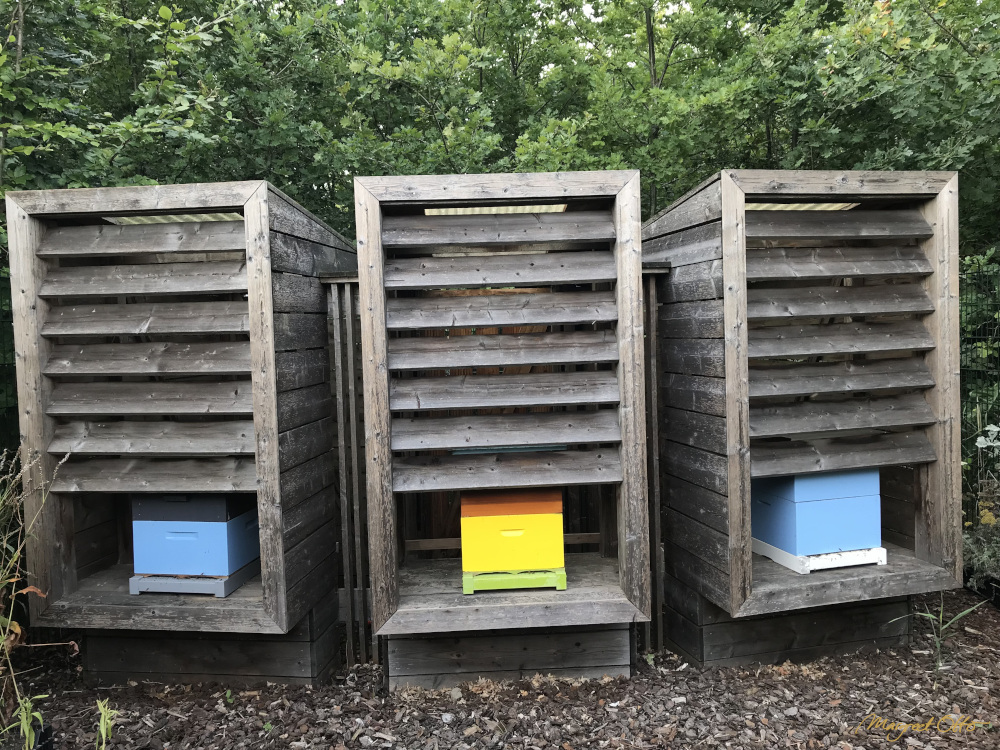
Even if these are more inactive today. The purpose of the migration is to make it easier for them to be connected.
That is nowadays an extra additional quest of the bee colony. Could this change the character of the swarm season from what it usually is?

DEER ALSO HAVE THAT ABILITY
I also get to see deer as an image, they also have that ability. The deer also have the ability to go to places independently, to be connected, yes I call it that, with immaterial energy fields. And deer often live close together in a closed area for as long as they can stay there. But they are less outgoing than they were a few hundred years ago.
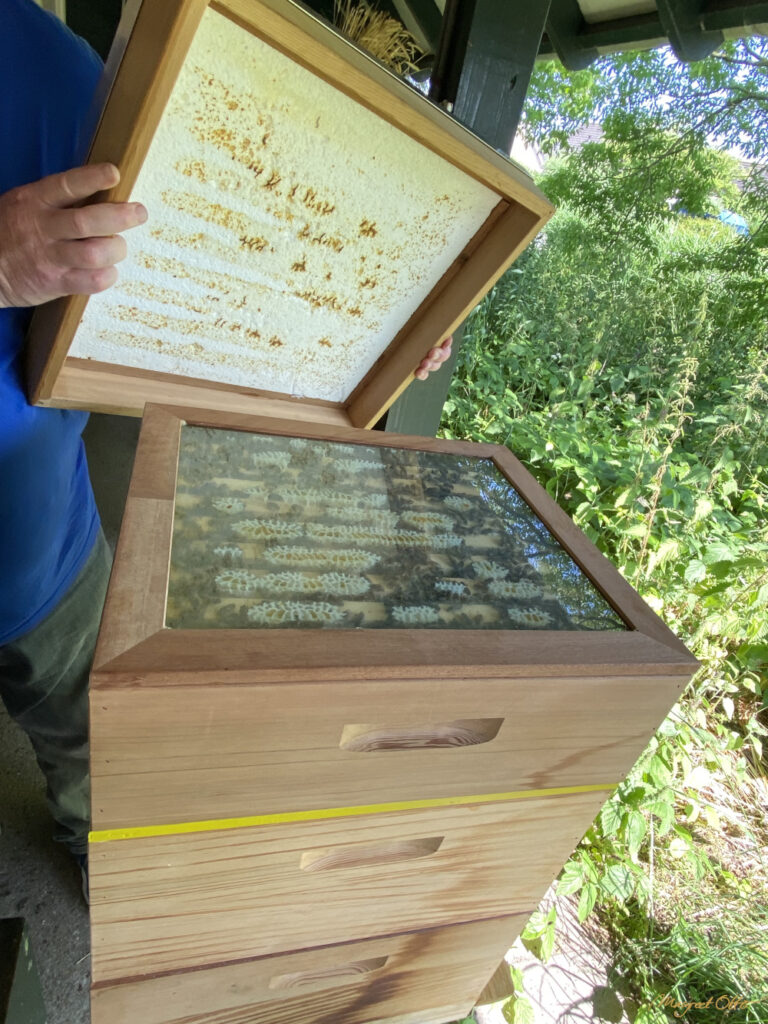
A special designed glass lid
so children and adults can have a glance
at the usually hidden beelife.
THE BEE-KEEPER
An ‘Imme’ or ‘Ieme’ is another word for honey bee in Dutch language. The word Beekeeper in Dutch language ‘Imker’ is derived from this. The imker is the person who keeps bees.
Beekeeping means that one facilitates accommodation for the bees in suitable places. As mentioned earlier in this article, those are man-made beehives. The best places for bees are estates where there is a lot of nature with flowers of plants and in spring the blossoms of trees.
The motivation of a beekeeper can be because they want to harvest honey, and/or because agricultural farmers want to promote the fertilization and seed formation of plants and crops on agricultural- and horticultural lands.
It may also be that people want to support the bee species for them to survive, out of a passion for bees, or even for all life.
For example, a beekeeper will also want to help the bee colonies in their survival when they cannot find accommodation and/or food themselves.
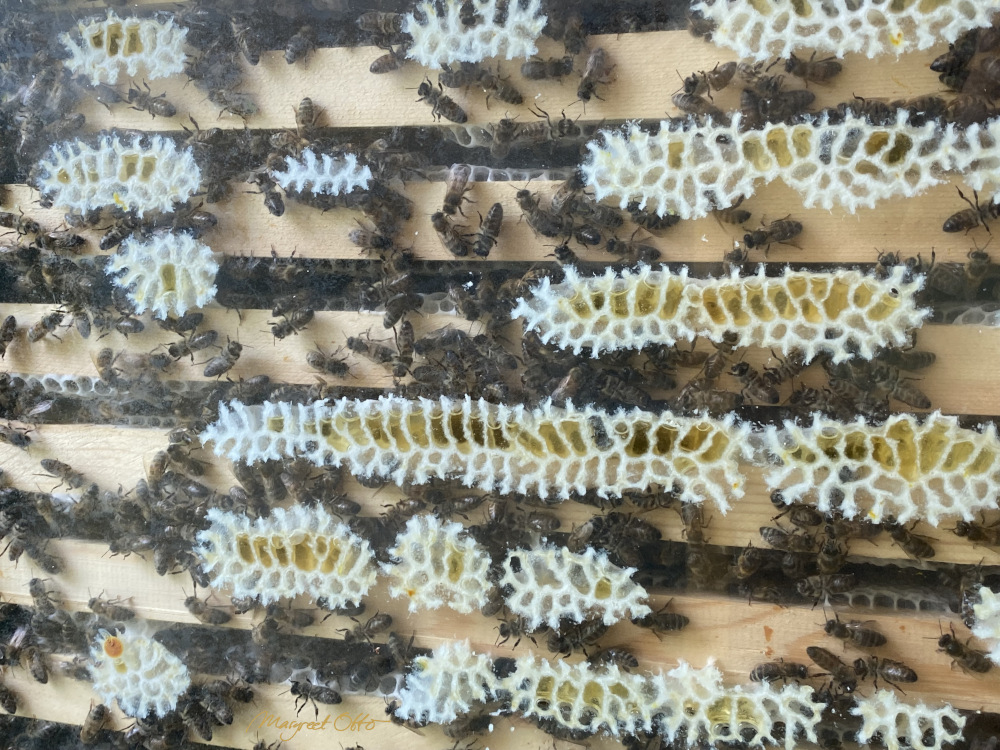
Seen from a spiritual perspective, the beekeeper is, as it were, the one who maintains the connection between bee colonies, but who can in fact also give a translation to other animal- or bird communities, so that these communities or groups do not approach each other unnecessarily.
After all, diverse nature realms with their own vital interests, are related to each other through the interplay of the immaterial world. This is significant because the common populations, but also other kinds of animal communities, are authorized to coexist with each other.
Competent here means: guiding groups to live together in a way of mutual interest, and to prevent groups from tormenting each other unnecessarily. (e.g. protecting groups from natural enemies by demarcating their territories).
Continue reading
PART TWO: CALL OF THE BEES
Back to MENU

